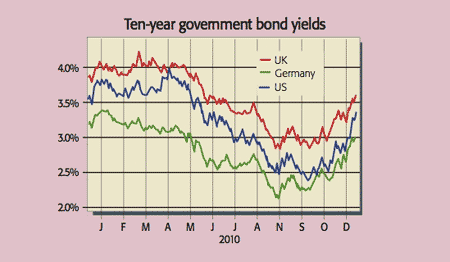
Bill Clinton’s campaign strategist, James Carville, said in the early 1990s that he wanted to be reincarnated as the bond market. It “can intimidate everyone”. And government debt markets have “lost none of their power” to reduce us “to a quivering wreck” with their occasional violent moves, says the FT.
Last week saw the biggest one-day sell-off in US Treasuries in two years. The ten-year yield (yields climb as prices fall) gained 0.2% on Tuesday and kept climbing. By the end of last week, ten-year borrowing costs had risen by 14%. The yield is now almost a whole percentage point above its October low. That’s a loss of more than 10% on a typical long-term bond fund since then, says MeanStreet’s Evan Newmark. “That’s real money.”
With America setting the tone, other major bond markets fell in tandem last week, continuing the trend of the past two months. British and German ten-year yields are both up by around 0.8% since October. There is no agreement on the key reason bonds have weakened so much of late. But whatever the cause, it is starting to look as though the bond bull market, which has lasted since the early 1980s when inflation was conquered, is ending.
Zero tolerance for debt
One explanation for recent bond-yield moves is mounting concern that “America is starting down the road to a European-style sovereign debt crisis”, says Jeremy Warner in The Daily Telegraph.
Last week’s compromise on taxes between President Obama and Congress could add almost a $1trn to the US deficit. Fiscal deficits are expected for the next ten years and, given the political stalemate, agreement on spending cuts and tax hikes looks more remote than ever. This is in stark contrast to other major economies, which are trying to get their debt under control. Yet more borrowing also means that those worried about the US inflating its debt away “are probably more concerned now”, says Deepa Majmudar of JPMorgan Asset Management.
Bond traders’ patience has “snapped”, says Liam Halligan in The Sunday Telegraph. The sell-off in debt markets on both sides of the Atlantic last week shows a “new mood of zero tolerance” among investors. Markets seem rattled by Britain’s fast-rising debt, while the rise in German yields reflects the realisation that Germany will have to “raise wads of cash to absorb the mess caused by other member states’ fiscal incontinence”.
Global growth improves
A less worrying view is that bond markets have factored in higher growth, and hence inflation. With the Federal Reserve determined to lift prices, and stronger data over the past few weeks in America, Britain and Germany, deflationary fears are easing. So “abnormally low” bond yields are rising, says Tony Crescenzi of Pimco. Last week’s US growth package, which added 1% to consensus growth forecasts for 2011, accelerated the trend.
“There is a strong inflationary element” to the recovery, notes Ian Campbell on Breakingviews. Commodities are up by a fifth since August; China is beginning to export inflation; and monetary policy could hardly be looser. Given consumer debt levels in America and Britain, central bankers will be loath to raise rates soon, says Warner. That increases the danger that they could leave it too late to cap inflation.
Bonds set for further falls
Whether the bullish or bearish view explains most of the movement in the markets, the point is that both bode ill for bonds. A recovery implies higher interest rates and hence lower bond prices. Meanwhile, inflation eats away at the fixed income that bonds offer.
If creditors are losing faith in governments, they will ditch their debt. We look set for falling bond prices, and hence rising yields, from these historically rock bottom levels. It’s the end of a 30-year bull run.